Summary of Climate Disasters on the Planet from October 2 to October 8, 2024
Thailand
Since early October, heavy rains have caused
one of the most severe floods in the last half-century
in the city of Chiang Mai, a popular tourist destination in Thailand.

The catastrophic flood affected a quarter of Thailand’s provinces
According to the Department of Disaster Prevention and Mitigation, the flood impacted more than a quarter or 20 out of 76 country's provinces. River levels rose to a “critical” point.
Tourists were evacuated from their hotels by trucks. Chiang Mai railway station was closed, suspending train service to the city. As of October 8, 2024, at least 6 people had died as a result of the disaster.
The overflowing Mae Taeng River flooded about 80% of the elephant rescue and rehabilitation center's area.

Volunteers and zoo staff rescuing elephants from the flooded sanctuary, Thailand
In addition to elephants, the sanctuary is home to thousands of cats, dogs, rabbits, and other animals. Hundreds of volunteers and sanctuary workers used boats to move animals under threat. The evacuation was complicated by the fact that many of the animals were old, sick, or injured, and some of the elephants were completely blind. Two elephants could not be saved and drowned.
Brazil
For the second year, Brazil is experiencing a prolonged drought. According to the Brazil’s National Center for Monitoring and Early Warning of Natural Disasters, the country is currently going through the most severe drought in its recorded history since 1950. Nearly 60% of Brazil’s territory has been affected.
According to the National Institute of Meteorology (Inmet), as of October 4, 2024, the city of Brasília, the country’s capital, had not seen rain for 164 days. This is a record for the longest drought in the region.
Due to critically low humidity combined with temperatures exceeding +35°C (95°F), an “orange alert” was declared in the capital.
The ongoing drought and decreased rainfall in the Amazon basin have led to a critical drop in the water level of the Rio Negro River. According to the Manaus port, on the morning of October 4, the river level was recorded at 12.66 meters (41.5 feet), the lowest in 120 years of observations (since 1902).
Businesses along the Rio Negro have been devastated by the drought. Ships and boats are stranded.
The Solimões River bed has turned into a long sandbar, forcing residents to walk home for hours under the scorching sun.
According to the Civil Defense, in the municipality of Manacapuru, about 100 km upriver from the capital of Amazonas state, Manaus, the depth of the Solimões river was only 3 meters (9.8 feet). In the municipality of Tabatinga, Amazonas state, the lowest water level for this time of year was recorded.
Fish, the primary food source for people living along the riverbanks, have disappeared from the dried-up water bodies.
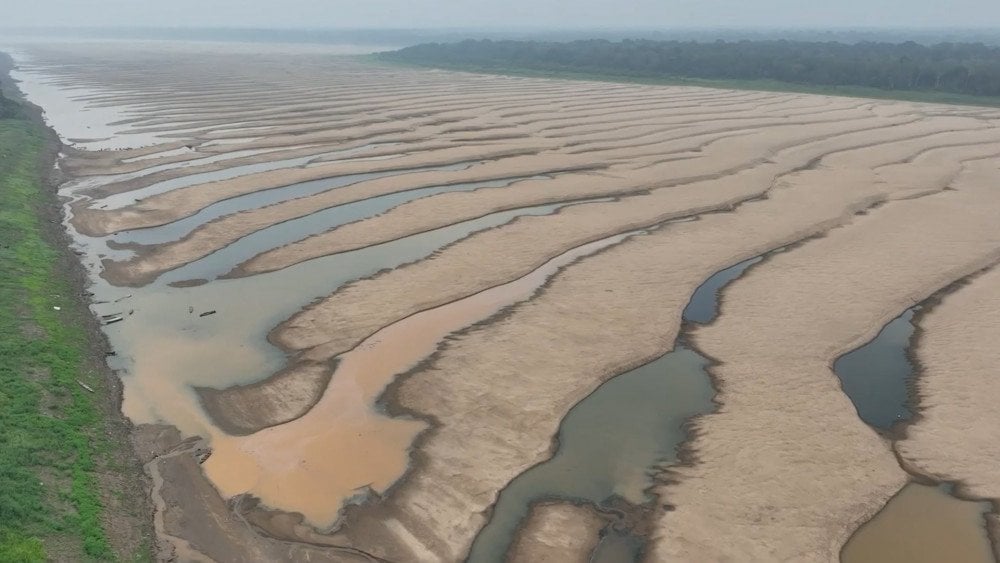
Riverbeds turned into sandbars, Amazonas state, Brazil
The region is also facing a critical shortage of drinking water, which is leading to an outbreak of intestinal infections. According to Civil Defense in the state of Amazonas, water levels in all river channels in the region are below the average norm for this time of year. The drought has already directly affected nearly 750,000 people, leaving them without food, water, and transportation.
A vast number of Amazon river dolphins have died due to the drying up of Lake Tefé. According to Miriam Marmontel, leader of the dolphin project at the Mamirauá Institute for Sustainable Development, by the end of September, they were finding at least one dead dolphin each day.
The drought has also caused unprecedented forest fires in Brazil, destroying large parts of the Amazon and Pantanal, the world’s largest tropical wetlands. The fires have also enveloped nearby cities in thick smoke.
A report by the National Institute for Space Research (INPE) noted that this year the number of forest fires in Brasília increased by 269% compared to previous years.
André Guimarães, Executive Director of the Amazon Environmental Research Institute, commented: “We are suffering from a situation we have never faced before.” The drought threatens to trigger a humanitarian crisis for more than 40 million people living in and around the Amazon. Residents rely on waterways not only for drinking water and bathing but also for transportation and food. Expert forecasts are disappointing. According to the National Center for Monitoring and Early Warning of Natural Disasters (Cemaden), significant rainfall is not expected in the coming weeks, and river levels will continue to drop.
Another unexpected aftermath of the drought and low river levels has been a massive landslide in the Amazonas state.
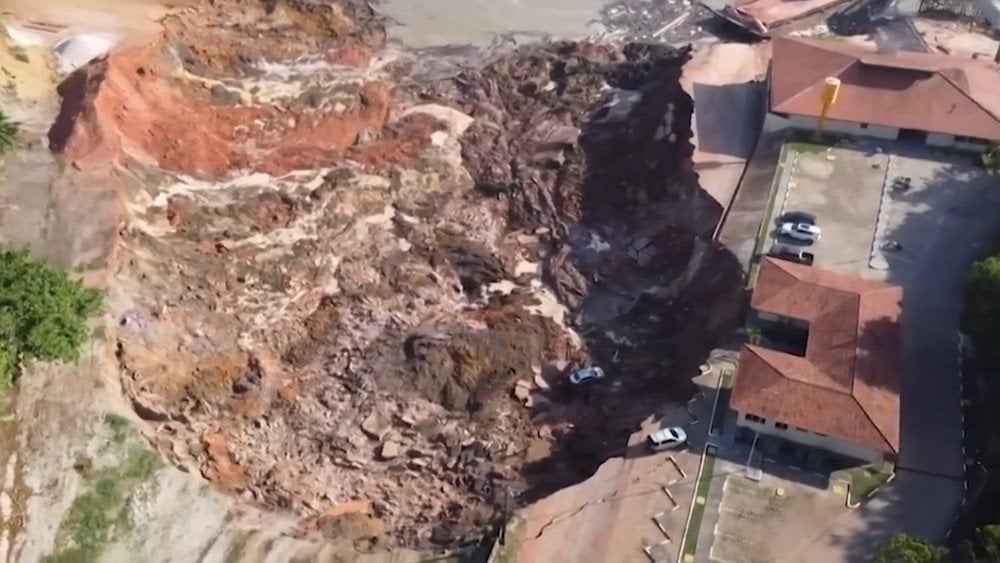
A huge landslide occurred at the Terra Preta port, Manacapuru municipality, Amazonas state, Brazil
On October 7, tons of earth collapsed onto moored vessels and floating houses at the Terra Preta port in Manacapuru municipality. According to Civil Defense in Manacapuru, at least 1 person was killed, 3 were reported missing, and 10 people were injured.
New Zealand
In the Otago region, for the first time in history, a red alert was issued due to life-threatening conditions on the river. The city of Dunedin experienced its rainiest day in a century. In just 24 hours, from October 3 to October 4, 2024, 130.8 mm (5.15 inches) of rain fell.
In 40 hours, rainfall exceeded October’s norm by 2.4 times.
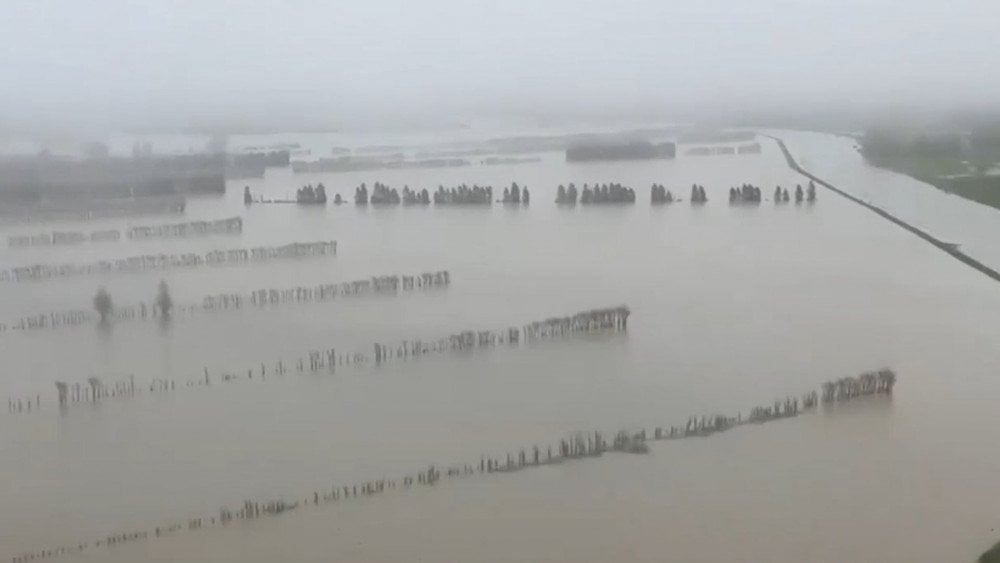
Aftermath of extreme rains in New Zealand
Residents of the Dunedin district helplessly watched as water rapidly flooded their homes. About 100 people were forced to evacuate during the night.
Due to extensive landslides, debris and damage in the Otago region, 130 roads and highways were closed, and in some areas residents were left without water and cell phone service.
Typhoon Krathon
On October 3, Typhoon Krathon hit the southwest of Taiwan, bringing winds with gusts up to 162 km/h (101 mph) and heavy downpours. The epicenter of the storm included the city of Kaohsiung and Pingtung County.
In the major port city of Kaohsiung, the wind tore roofs off buildings and destroyed infrastructure. More than 2,000 trees were uprooted across the city.

Strong winds tear the roof off a building, Taiwan Island
Areas with container terminals were hit particularly hard — powerful wind gusts scattered containers across the port, blocking docks. Many roads were clogged with fallen trees and debris, complicating rescue operations. Nearly 100,000 homes were left without electricity, and 129,000 without water.
As a result of the disaster, two people were killed, 667 were injured, and more than 10,000 people were evacuated. The country has declared a state of emergency and mobilized more than 40,000 troops to provide aid.
Experts noted three peculiarities of Typhoon Krathon.
Firstly, before making landfall, it mysteriously stalled off the coast for several days.
Secondly, the typhoon hit the densely populated southwest coast of the island, a region rarely impacted by such storms. Typically, typhoons approach from the east, where mountains weaken their strength, but the lack of such protection in the west amplified the destructive effects. Krathon was the first typhoon to hit Kaohsiung in 47 years.
Thirdly, Krathon moved very slowly, at a speed of only 4 km/h (2.5 mph), allowing it to dump enormous amounts of rain on the affected areas. In some places, nearly 1.7 meters (5.6 feet) of rain fell over several days.
Greece
On October 4, the Greek region of Aetolia-Akarnania and the island of Corfu were at the center of the storm Cassandra.
A small river overflowed, causing destruction in the city of Stratos: basements were flooded, and significant damage was done to warehouses, businesses, and farms.

The river overflow caused destruction in Stratos, Greece
The mayor of the city said, “An enormous volume of water came like a tsunami. 40-year-old olive trees were uprooted, and animals were swept away by the powerful currents. Complete destruction occurred in just a few minutes.” One person was swept away by the raging waters and, tragically, lost their life.
The storm system also impacted parts of northern Italy and the Western Balkans.
Bosnia and Herzegovina
On October 4, heavy rains struck Bosnia and Herzegovina. The central and southern regions of the country were flooded, and landslides isolated entire towns and villages.
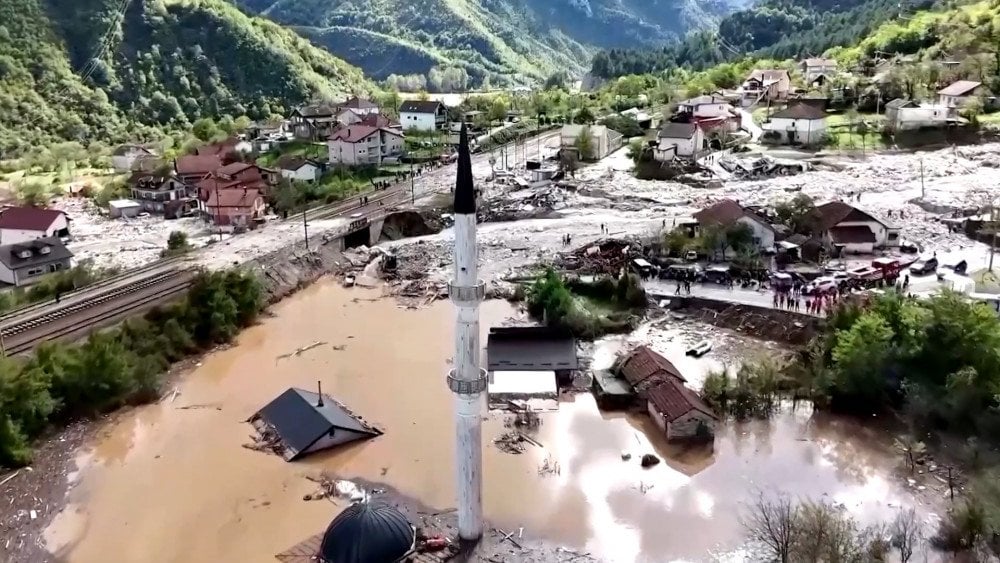
Catastrophic destruction in Jablanica, Bosnia and Herzegovina
One of the hardest-hit places was the town of Jablanica, located 70 km (43.5 miles) southwest of Sarajevo.
Floodwaters rushed into the homes of sleeping people,
and the residents could not leave their homes. In addition to rescuers, the army and civil defense forces provided aid to the population.
Landslides wiped out everything in their path. Buildings were buried under earth and stones, with only the minaret of a mosque remaining visible. A landslide blocked the main M-17 route running along the Neretva River. Water eroded the ground beneath the tracks, leaving a 200-meter (656-foot) section of the railway hanging in the air.
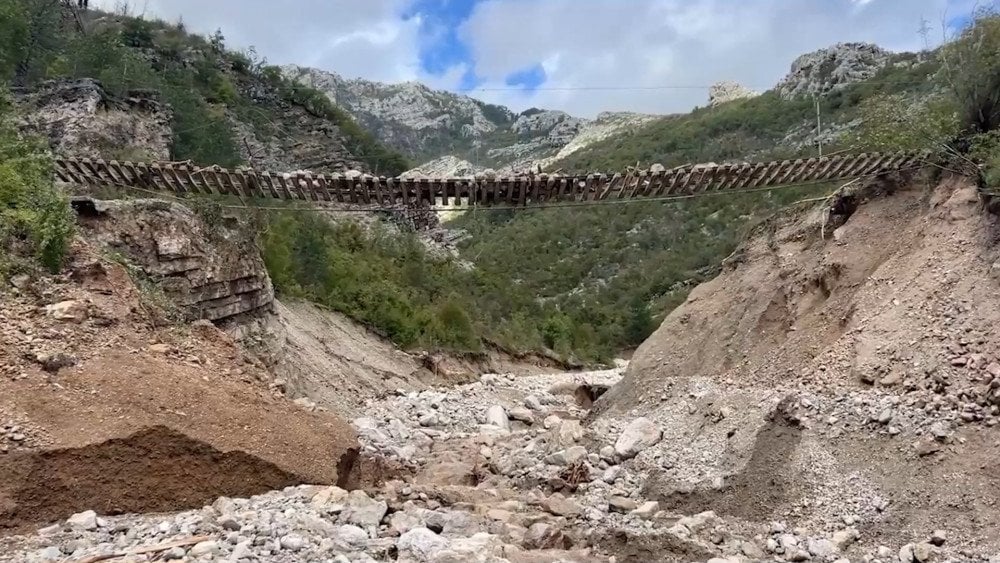
Due to ground erosion, a 200-meter section of the railway was left hanging in the air, Bosnia and Herzegovina
The town of Kiseljak, located 20 km (12.4 miles) west of Sarajevo, was also hit by the disaster: the river overflowed its banks, flooding hundreds of homes. Small streams turned into raging rivers, washing away everything in their path.
Local residents, even the elderly, noted that they do not recall anything like this happening before. As of October 8, 2024, the climate disaster had claimed the lives of 22 people, with dozens more reported missing.
The disaster also impacted neighboring countries: Montenegro and Croatia. On October 5, in the Croatian city of Podgora, nearly two months’ worth of rain—143 mm (5.63 inches)—fell in just one hour (an average October rainfall is 79.4 mm (3.13 inches)). Floodwaters inundated streets, yards, basements, and waterfronts.
Hurricane Milton
Barely two weeks after the deadly blow of Hurricane Helen to the U.S. state of Florida (Hurricane Helen hit Florida, USA, on September 26), Hurricane Milton appeared on the horizon, shocking meteorologists.
It took Hurricane Milton just over 12 hours to intensify from Category 1 to the highest Category 5. Its wind speeds reached 290 km/h (180 mph). In anticipation of the hurricane's landfall, millions of people were evacuated and crews rushed to clear debris and wreckage left by Hurricane Helen, which could become dangerous projectiles under the extreme winds.
As it approached the coast, Milton spawned at least 27 tornadoes in the state of Florida, which, as of October 10, had killed at least 4 people in St. Lucie County. Hundreds of homes were destroyed.

All that remains of a house after the destructive tornadoes caused by Hurricane Milton in Florida, USA
On the evening of October 9, Milton made landfall on Florida’s coast, near Siesta Key Island in Sarasota County, as a Category 3 hurricane.
It caused life-threatening storm surges and strong winds of up to 193 km/h (120 mph). More than 3.3 million Florida residents were left without power. In some counties, power outages affected 70% of the population.
The amount of rainfall brought by the hurricane exceeded forecasts—in just a few hours, up to five months’ worth of rain fell.
In the city of St. Petersburg, Florida, strong wind gusts caused a tower crane to collapse onto a neighboring building. The roof of Tropicana Field stadium, home of the Tampa Bay Rays baseball team, was also torn off. 406.4 mm (16 inches) of rain fell in the city within just 3 hours, exceeding the region’s three-month average rainfall.
The hurricane caused the deaths of at least 23 people in Florida, and the full extent of the damage is yet to be assessed.
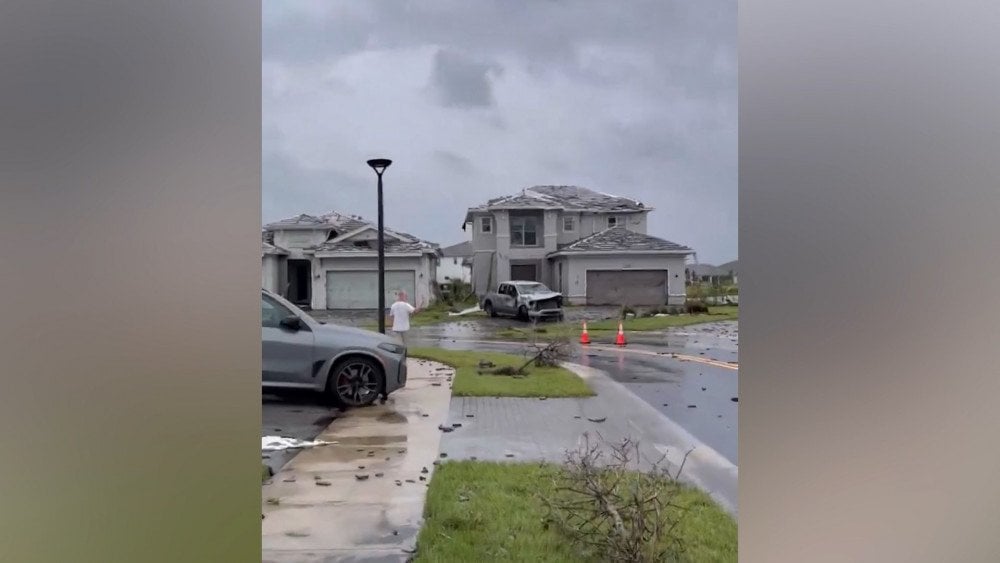
Devastation on city streets after Hurricane Milton in Florida, USA
“Milton” isn’t just another hurricane; its anomalous and unpredictable behavior is yet another manifestation of the climate chaos that the world has ignored for too long!
The events on the planet are a warning that if we don't start addressing the climate problem urgently, we will face even more dire consequences.
Are you ready to accept the inevitable or will you do all you can to prevent it?
You can watch the video version of this article here:
Leave a comment